Interfacial Characteristics and Mechanical Performance of IN718/CuSn10 Fabricated by Laser Powder Bed Fusion
Abstract
1. Introduction
2. Experimental Procedure
2.1. Materials
2.2. Laser Powder Bed Fusion Process
2.3. Microstructural Characterization
2.4. Mechanical Characterization
3. Results and Discussion
3.1. Microstructure
3.2. Elemental Distribution
3.3. Crystallography
3.4. Mechanical Properties
4. Conclusions
- (1)
- Good metallurgical bonding was achieved at the IN718/CuSn10 interface, with a transition zone width of approximately 750 μm, indicating sufficient element diffusion and metallurgical reactions between the two materials.
- (2)
- Due to the significant differences in thermophysical properties between IN718 and CuSn10, microcracks occurred at the interface. These microcracks significantly adversely affected the hardness and tensile properties, impairing the interfacial bonding performance.
- (3)
- The grain size at the interface was significantly decreased, forming a fine-grained zone that effectively dispersed stress concentration.
- (4)
- Microcracks, elemental segregation, and microstructural inhomogeneity were identified as the main factors affecting the mechanical properties. Further improvements in the overall performance of the material could be achieved by promoting the formation of equiaxed grains to disperse stress and eliminate defects.
Author Contributions
Funding
Data Availability Statement
Conflicts of Interest
Abbreviations
| LPBF | Laser Powder Bed Fusion |
| AM | Addictive manufacturing |
| MM-AM | Multi-material Addictive manufacturing |
| MM-LPBF | Multi-material LPBF |
References
- Chen, B.; Zhuo, L.; Xie, Y.; Huang, S.; Wang, T.; Yan, T.; Gong, X.; Wang, Y. Comparative Study on Microstructure, Mechanical and High Temperature Oxidation Resistant Behaviors of SLM IN718 Superalloy before and after Heat Treatment. J. Mater. Res. Technol. 2024, 31, 1535–1546. [Google Scholar] [CrossRef]
- Chen, T.; Yang, L.; Huang, Y.; Zhao, S.; Wu, W.; Ma, H.; Zhang, Q.; Fan, S.; Sun, J. The Surface Morphologies and Internal Pores Evolution of a CuSn10 Alloy Fabricated by Laser Powder Bed Fusion. J. Mater. Res. Technol. 2024, 31, 898–907. [Google Scholar] [CrossRef]
- Ahn, B. Recent Advances in Brazing Fillers for Joining of Dissimilar Materials. Metals 2021, 11, 1037. [Google Scholar] [CrossRef]
- Devarajan, D.K.; Rangasamy, B.; Amirtharaj Mosas, K.K. State-of-the-Art Developments in Advanced Hard Ceramic Coatings Using PVD Techniques for High-Temperature Tribological Applications. Ceramics 2023, 6, 301–329. [Google Scholar] [CrossRef]
- Guo, N.; Leu, M.C. Additive Manufacturing: Technology, Applications and Research Needs. Front. Mech. Eng. 2013, 8, 215–243. [Google Scholar] [CrossRef]
- Wei, C.; Zhang, Z.; Cheng, D.; Sun, Z.; Zhu, M.; Li, L. An Overview of Laser-Based Multiple Metallic Material Additive Manufacturing: From Macro- to Micro-Scales. Int. J. Extrem. Manuf. 2021, 3, 012003. [Google Scholar] [CrossRef]
- Ma, Z.; Liu, W.; Li, W.; Liu, H.; Song, J.; Liu, Y.; Huang, Y.; Xia, Y.; Wang, Z.; Liu, B.; et al. Additive Manufacturing of Functional Gradient Materials: A Review of Research Progress and Challenges. J. Alloys Compd. 2024, 971, 172642. [Google Scholar] [CrossRef]
- Van Cleemput, M.; Jones, H.; Van Der Burgt, M.; Barrau, J.-R.; Lee, J.A.; Eyssa, Y.; Schneider-Muntau, H.-J. Copper/Stainless Steel Conductor for High Field Pulsed Magnets. Phys. B Condens. Matter 1996, 216, 226–229. [Google Scholar] [CrossRef]
- Cheng, Z.; Liu, H.; Huang, J.; Ye, Z.; Yang, J.; Chen, S. MIG-TIG Double-Sided Arc Welding of Copper-Stainless Steel Using Different Filler Metals. J. Manuf. Process. 2020, 55, 208–219. [Google Scholar] [CrossRef]
- Kim, S.H.; Lee, H.; Yeon, S.M.; Aranas, C.; Choi, K.; Yoon, J.; Yang, S.W.; Lee, H. Selective Compositional Range Exclusion via Directed Energy Deposition to Produce a Defect-Free Inconel 718/SS 316L Functionally Graded Material. Addit. Manuf. 2021, 47, 102288. [Google Scholar] [CrossRef]
- Scaramuccia, M.G.; Demir, A.G.; Caprio, L.; Tassa, O.; Previtali, B. Development of Processing Strategies for Multigraded Selective Laser Melting of Ti6Al4V and IN718. Powder Technol. 2020, 367, 376–389. [Google Scholar] [CrossRef]
- Zhang, Y.; Bandyopadhyay, A. Direct Fabrication of Bimetallic Ti6Al4V + Al12Si Structures via Additive Manufacturing. Addit. Manuf. 2019, 29, 100783. [Google Scholar] [CrossRef] [PubMed]
- Nguyen, D.-S.; Park, H.-S.; Lee, C.-M. Applying Selective Laser Melting to Join Al and Fe: An Investigation of Dissimilar Materials. Appl. Sci. 2019, 9, 3031. [Google Scholar] [CrossRef]
- Onuike, B.; Heer, B.; Bandyopadhyay, A. Additive Manufacturing of Inconel 718—Copper Alloy Bimetallic Structure Using Laser Engineered Net Shaping (LENSTM). Addit. Manuf. 2018, 21, 133–140. [Google Scholar] [CrossRef]
- Grandhi, M.; Nguyen, V.; Liu, Z.; Romo-De-La-cruz, C.-O.; Song, X. Copper-Nickel Functionally Magnetic Gradient Material Fabricated via Directed Energy Deposition. J. Manuf. Process. 2023, 100, 47–54. [Google Scholar] [CrossRef]
- Liu, L.; Wang, D.; Han, C.; Li, Y.; Wang, T.; Wei, Y.; Zhou, W.; Yan, M.; Liu, Y.; Wei, S.; et al. Additive Manufacturing of Multi-Materials with Interfacial Component Gradient by in-Situ Powder Mixing and Laser Powder Bed Fusion. J. Alloys Compd. 2024, 978, 173508. [Google Scholar] [CrossRef]
- Kah, P.; Shrestha, M.; Martikainen, J. Trends in Joining Dissimilar Metals by Welding. Appl. Mech. Mater. 2013, 440, 269–276. [Google Scholar] [CrossRef]
- Chen, J.; Yang, Y.; Song, C.; Zhang, M.; Wu, S.; Wang, D. Interfacial Microstructure and Mechanical Properties of 316L /CuSn10 Multi-Material Bimetallic Structure Fabricated by Selective Laser Melting. Mater. Sci. Eng. A 2019, 752, 75–85. [Google Scholar] [CrossRef]
- Wei, C.; Gu, H.; Li, Q.; Sun, Z.; Chueh, Y.; Liu, Z.; Li, L. Understanding of Process and Material Behaviours in Additive Manufacturing of Invar36/Cu10Sn Multiple Material Components via Laser-Based Powder Bed Fusion. Addit. Manuf. 2021, 37, 101683. [Google Scholar] [CrossRef]
- Brueckner, F.; Riede, M.; Müller, M.; Marquardt, F.; Willner, R.; Seidel, A.; Lopéz, E.; Leyens, C.; Beyer, E. Enhanced Manufacturing Possibilities Using Multi-Materials in Laser Metal Deposition. J. Laser Appl. 2018, 30, 032308. [Google Scholar] [CrossRef]
- King, W.E.; Barth, H.D.; Castillo, V.M.; Gallegos, G.F.; Gibbs, J.W.; Hahn, D.E.; Kamath, C.; Rubenchik, A.M. Observation of Keyhole-Mode Laser Melting in Laser Powder-Bed Fusion Additive Manufacturing. J. Mater. Process. Technol. 2014, 214, 2915–2925. [Google Scholar] [CrossRef]
- Bai, Y.; Zhang, J.; Zhao, C.; Li, C.; Wang, H. Dual Interfacial Characterization and Property in Multi-Material Selective Laser Melting of 316L Stainless Steel and C52400 Copper Alloy. Mater. Charact. 2020, 167, 110489. [Google Scholar] [CrossRef]
- Shakerin, S.; Hadadzadeh, A.; Amirkhiz, B.S.; Shamsdini, S.; Li, J.; Mohammadi, M. Additive Manufacturing of Maraging Steel-H13 Bimetals Using Laser Powder Bed Fusion Technique. Addit. Manuf. 2019, 29, 100797. [Google Scholar] [CrossRef]
- Liu, S.; Jie, J.; Guo, Z.; Yin, G.; Wang, T.; Li, T. Solidification Microstructure Evolution and Its Corresponding Mechanism of Metastable Immiscible Cu80Fe20 Alloy with Different Cooling Conditions. J. Alloys Compd. 2018, 742, 99–106. [Google Scholar] [CrossRef]
- Chen, K.; Wang, C.; Hong, Q.; Wen, S.; Zhou, Y.; Yan, C.; Shi, Y. Selective Laser Melting 316L/CuSn10 Multi-Materials: Processing Optimization, Interfacial Characterization and Mechanical Property. J. Mater. Process. Technol. 2020, 283, 116701. [Google Scholar] [CrossRef]
- Hu, Z.; Ma, Z.; Yu, L.; Liu, Y. Functionally Graded Materials with Grain-Size Gradients and Heterogeneous Microstructures Achieved by Additive Manufacturing. Scr. Mater. 2023, 226, 115197. [Google Scholar] [CrossRef]
- Zhang, D.; Prasad, A.; Bermingham, M.J.; Todaro, C.J.; Benoit, M.J.; Patel, M.N.; Qiu, D.; StJohn, D.H.; Qian, M.; Easton, M.A. Grain Refinement of Alloys in Fusion-Based Additive Manufacturing Processes. Metall. Mater. Trans. A 2020, 51, 4341–4359. [Google Scholar] [CrossRef]
- Tao, P.; Li, H.; Huang, B.; Hu, Q.; Gong, S.; Xu, Q. The Crystal Growth, Intercellular Spacing and Microsegregation of Selective Laser Melted Inconel 718 Superalloy. Vacuum 2019, 159, 382–390. [Google Scholar] [CrossRef]
- Zheng, Y.; Zhang, K.; Liu, T.T.; Liao, W.H.; Zhang, C.D.; Shao, H. Cracks of Alumina Ceramics by Selective Laser Melting. Ceram. Int. 2019, 45, 175–184. [Google Scholar] [CrossRef]
- Zhang, L.; Dong, P.; Zeng, Y.; Yao, H.; Chen, J. Additive Manufacturing of Inconel 718/CuCrZr Multi-Metallic Materials Fabricated by Laser Powder Bed Fusion. Addit. Manuf. 2024, 92, 104377. [Google Scholar] [CrossRef]
- Xu, J.-Y.; Yuan, W.-H.; Zhang, C.; Pan, J.; Yin, S.; Chen, H.; Liu, L. Improving the Processability and Grain Structures of Additively Manufactured Al-Fe-Cu-xZr Alloy: Experiment and High-Fidelity Simulation. Addit. Manuf. 2024, 84, 104074. [Google Scholar] [CrossRef]
- Zhuo, L.; Jiang, C.; Xu, J.; Wang, H.; Huang, B.; Zhang, D.; Wang, Y. Microstructural Evolution and Performance Optimization of SLM-Fabricated W/AlSi10Mg Composites. J. Alloys Compd. 2025, 1010, 178317. [Google Scholar] [CrossRef]
- Wen, Y.; Wu, X.; Huang, A.; Narayan, R.L.; Wang, P.; Zhang, L.; Zhang, B.; Ramamurty, U.; Qu, X. Laser Powder Bed Fusion of Immiscible Steel and Bronze: A Compositional Gradient Approach for Optimum Constituent Combination. Acta Mater. 2024, 264, 119572. [Google Scholar] [CrossRef]
- Sun, P.; Qiu, C. Influence of Addition of TiAl Particles on Microstructural and Mechanical Property Development in a Selectively Laser Melted Stainless Steel. Mater. Sci. Eng. A 2021, 826, 141925. [Google Scholar] [CrossRef]
- Cao, J.; Liu, F.; Lin, X.; Huang, C.; Chen, J.; Huang, W. Effect of Overlap Rate on Recrystallization Behaviors of Laser Solid Formed Inconel 718 Superalloy. Opt. Laser Technol. 2013, 45, 228–235. [Google Scholar] [CrossRef]
- Choi, J.-P.; Shin, G.-H.; Yang, S.; Yang, D.-Y.; Lee, J.-S.; Brochu, M.; Yu, J.-H. Densification and Microstructural Investigation of Inconel 718 Parts Fabricated by Selective Laser Melting. Powder Technol. 2017, 310, 60–66. [Google Scholar] [CrossRef]
- Mehta, A.; Zhou, L.; Hyer, H.; Huynh, T.; Lu, B.; Graydon, K.; Drobner, E.J.; Park, S.H.; Sohn, Y. Microstructural Characteristics and Mechanical Properties of Additively Manufactured Cu–10Sn Alloys by Laser Powder Bed Fusion. Mater. Sci. Eng. A 2022, 838, 142775. [Google Scholar] [CrossRef]
- Kang, S.-G.; Gainov, R.; Heußen, D.; Bieler, S.; Sun, Z.; Weinberg, K.; Dehm, G.; Ramachandramoorthy, R. Green Laser Powder Bed Fusion Based Fabrication and Rate-Dependent Mechanical Properties of Copper Lattices. Mater. Des. 2023, 231, 112023. [Google Scholar] [CrossRef]
- Wang, D.; Liu, L.; Deng, G.; Deng, C.; Bai, Y.; Yang, Y.; Wu, W.; Chen, J.; Liu, Y.; Wang, Y.; et al. Recent Progress on Additive Manufacturing of Multi-Material Structures with Laser Powder Bed Fusion. Virtual Phys. Prototyp. 2022, 17, 329–365. [Google Scholar] [CrossRef]
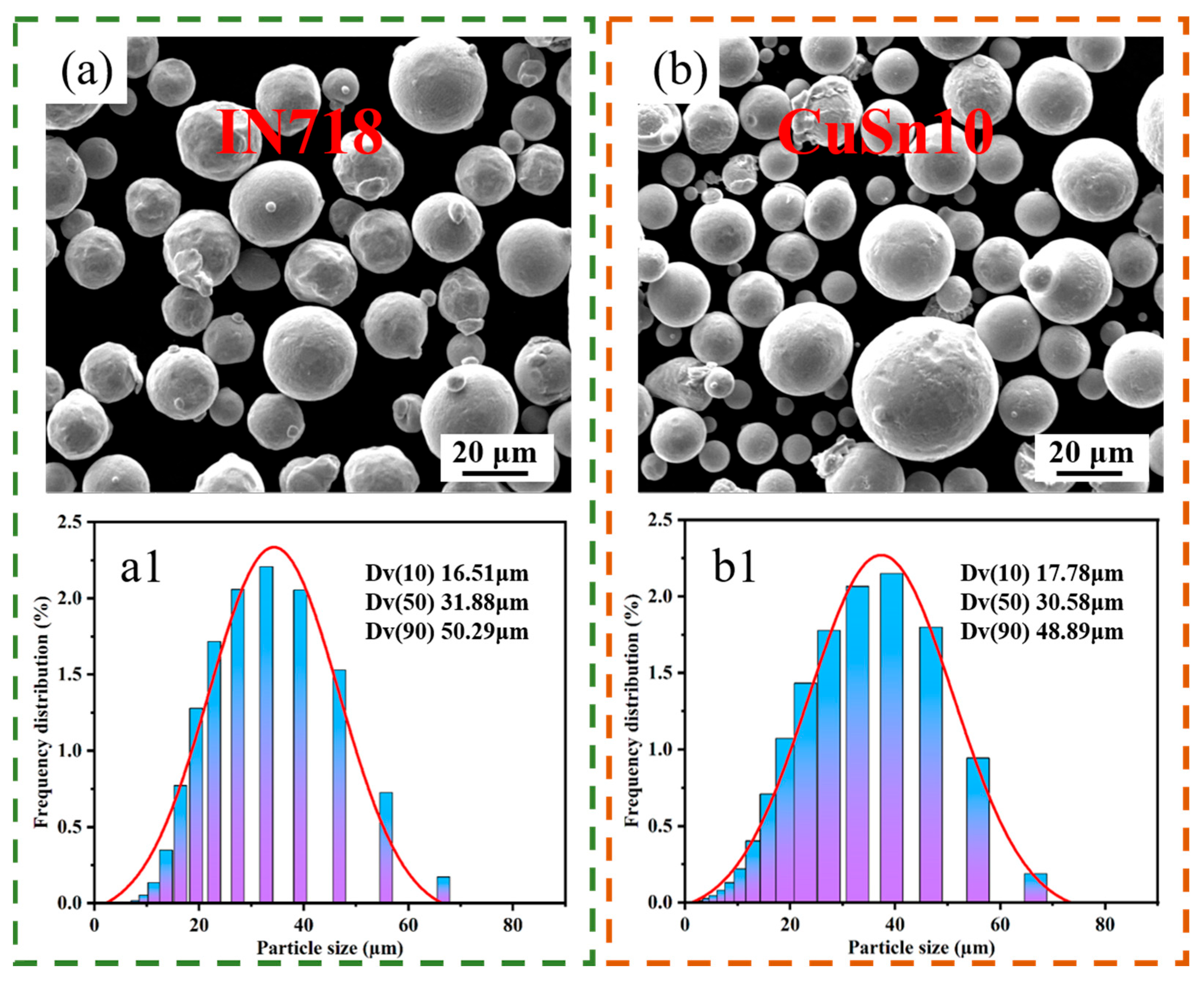
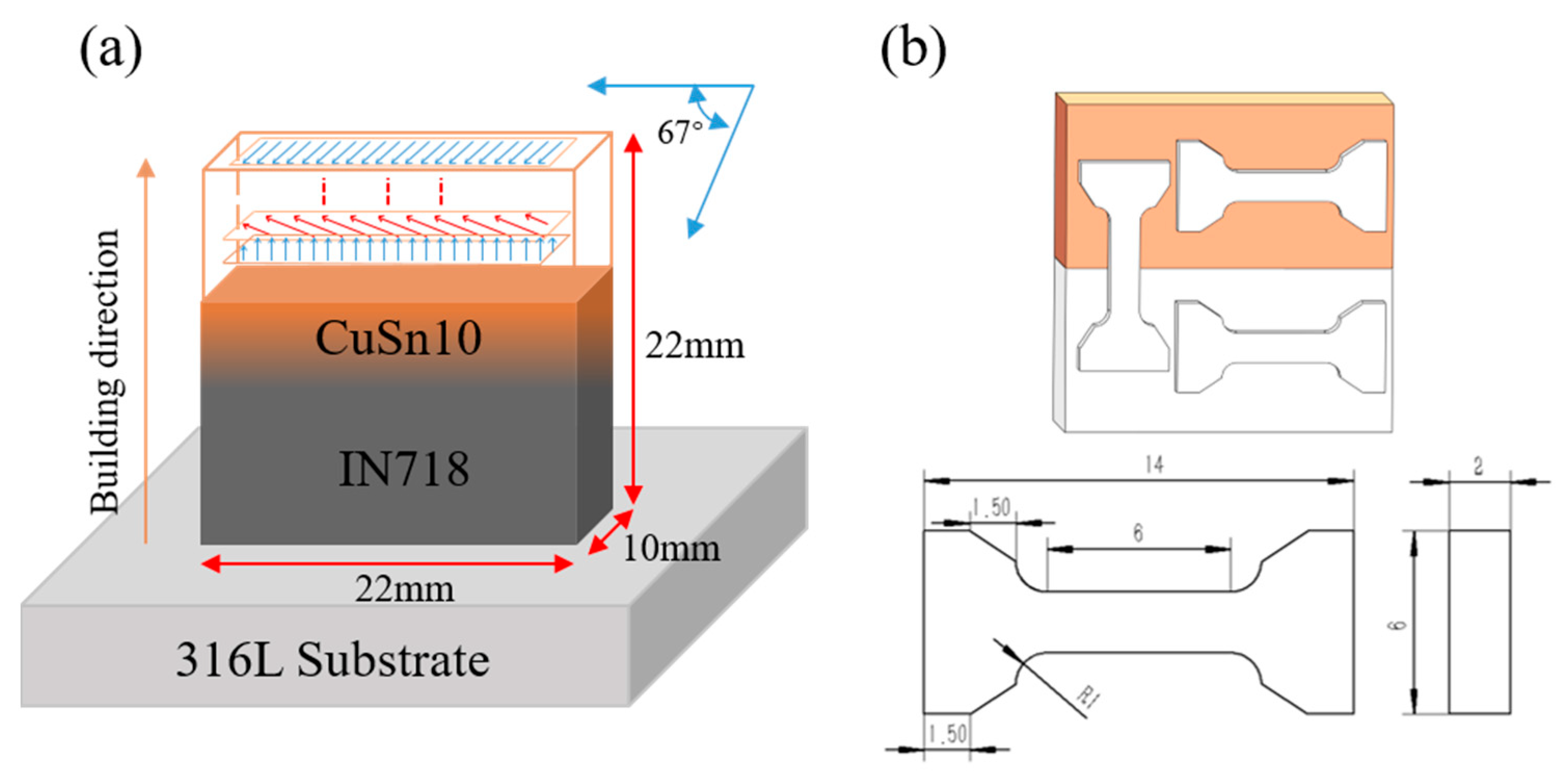
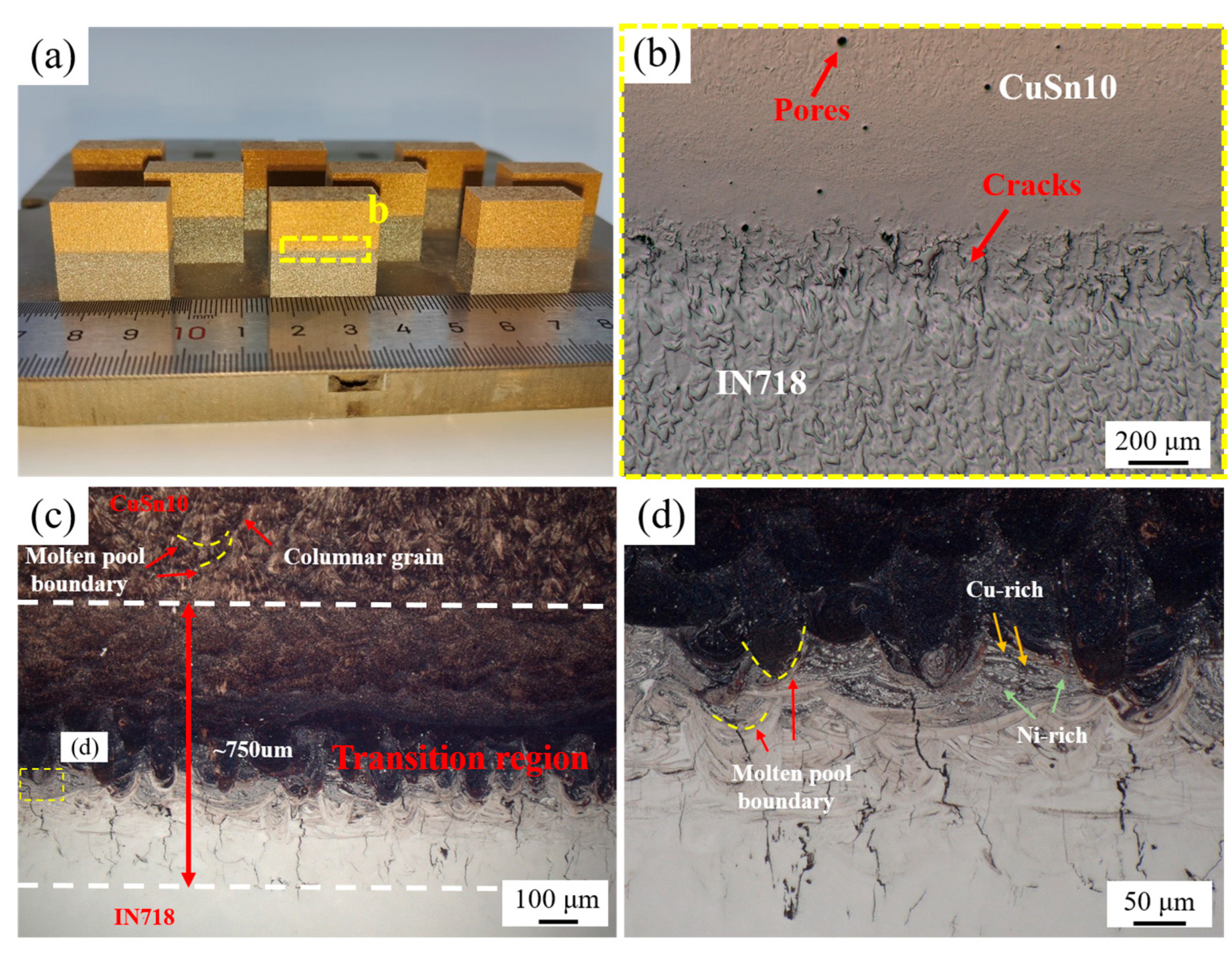
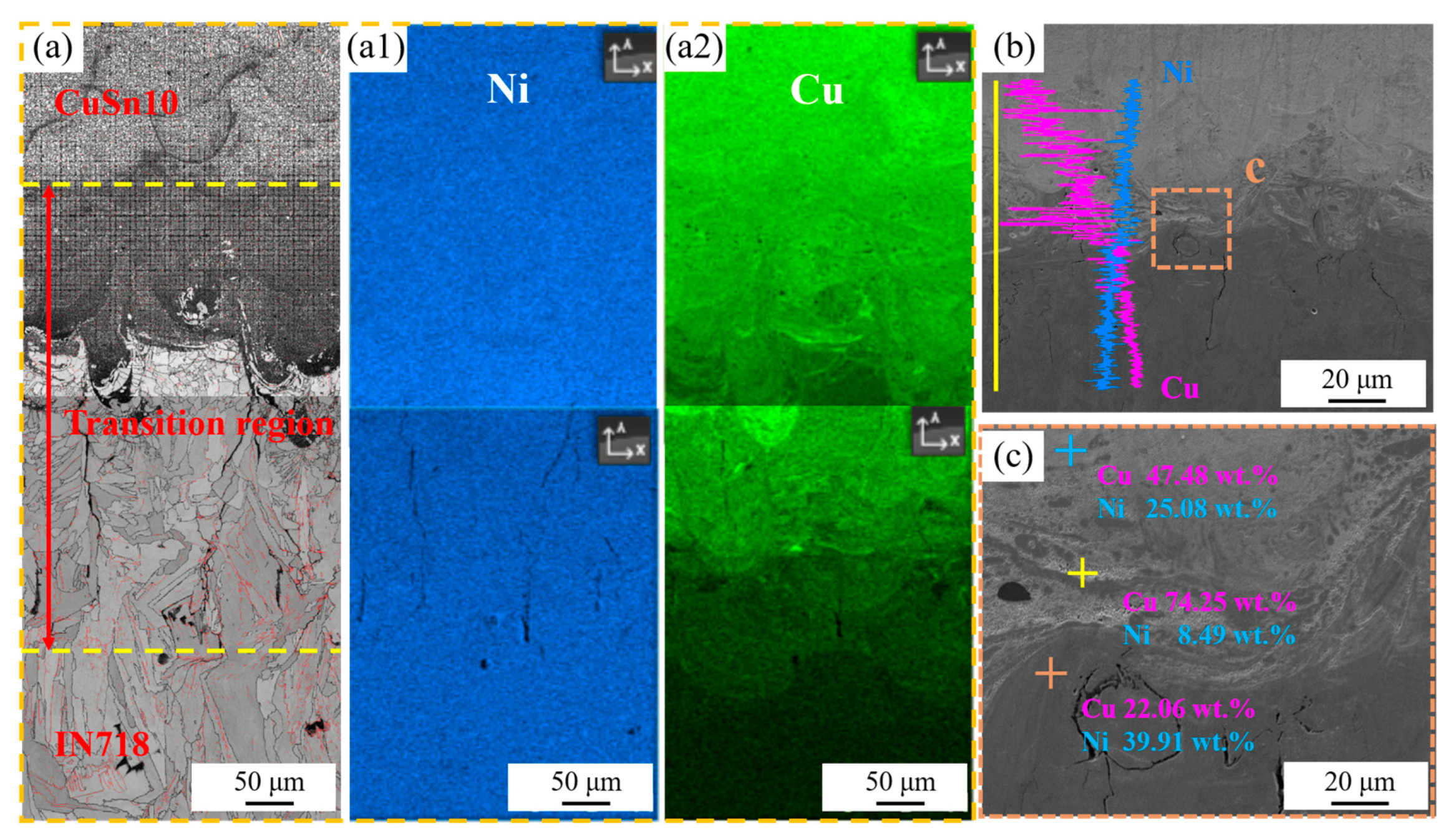
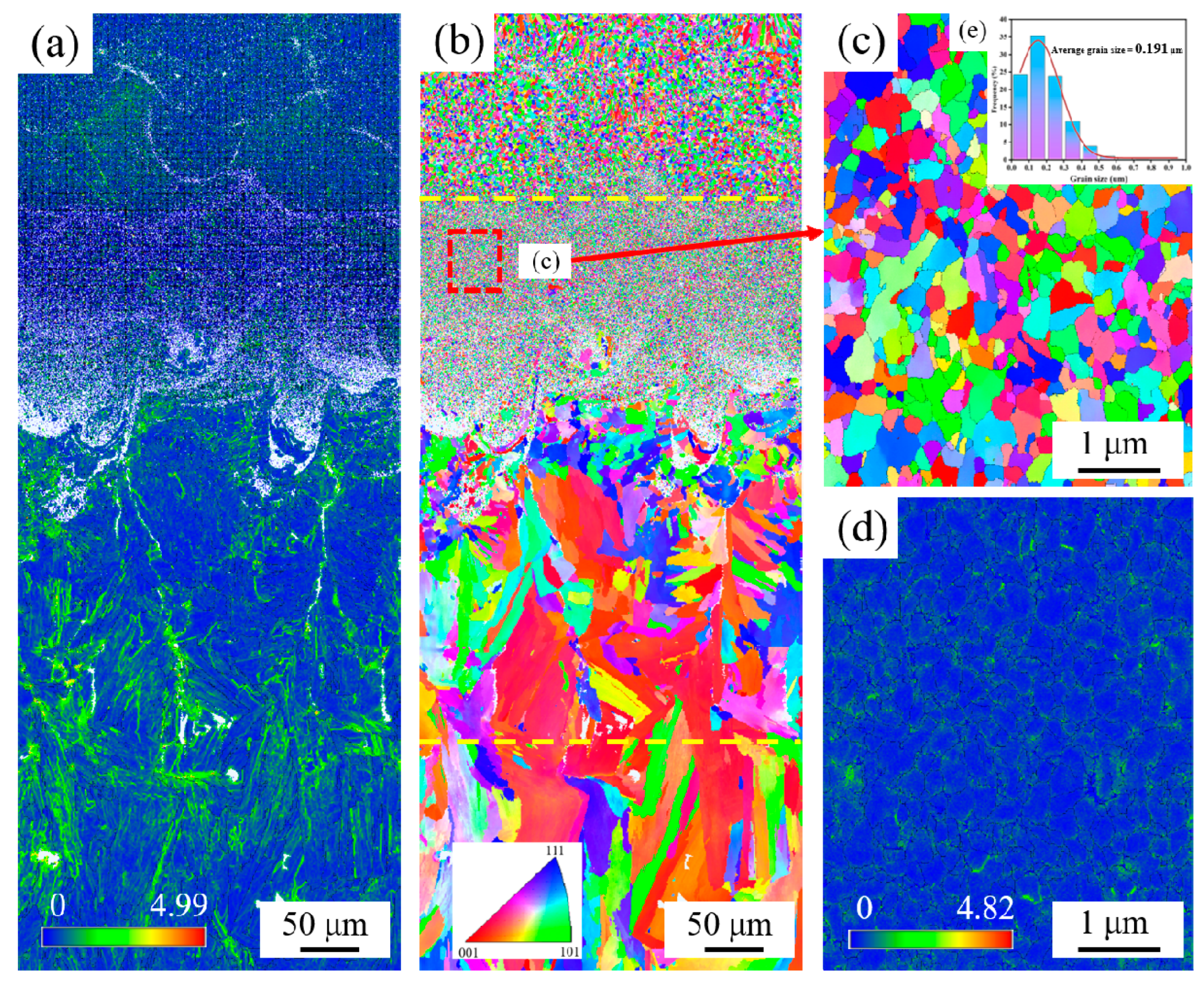
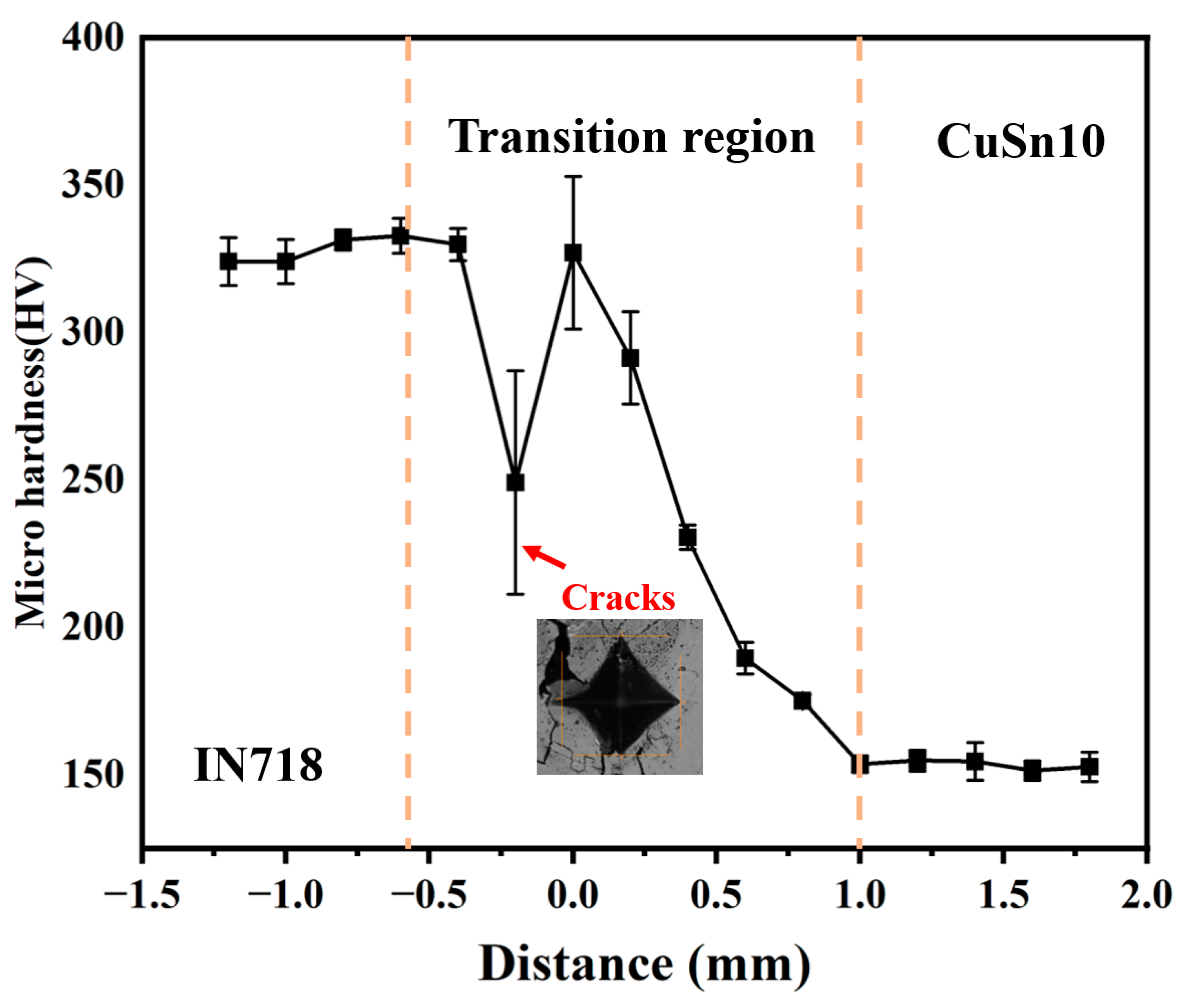
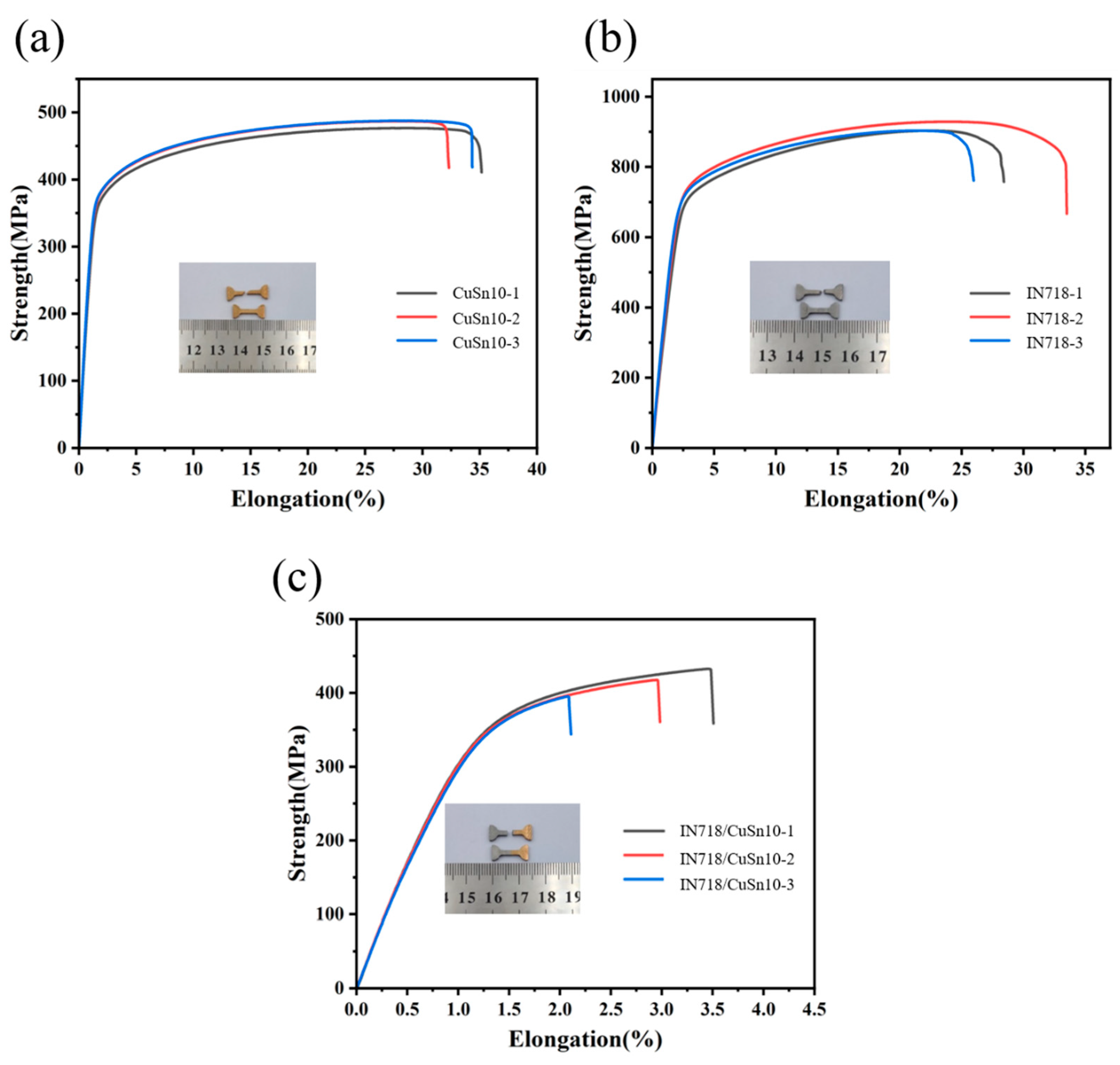
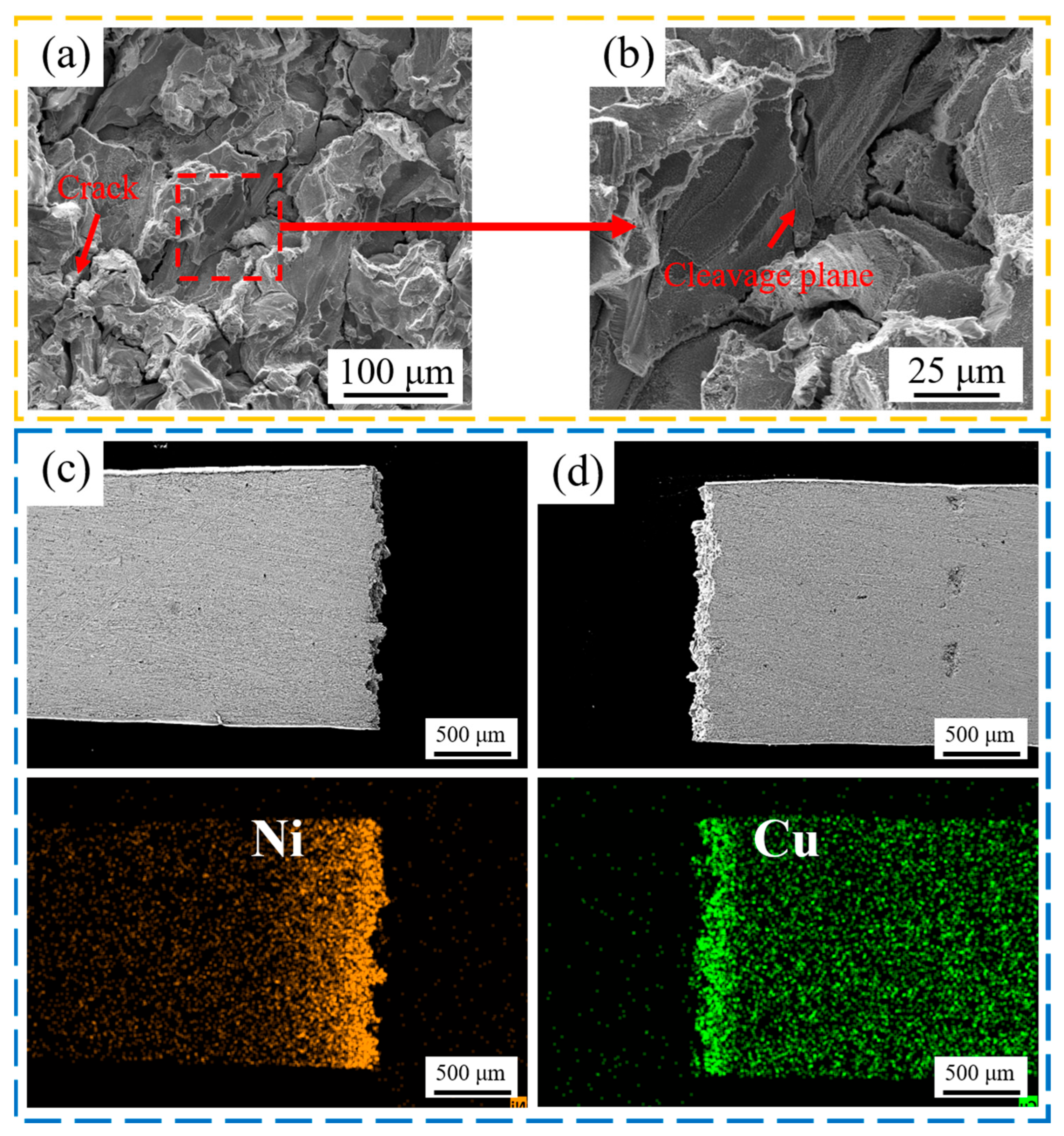
| Item | Parameter |
|---|---|
| Laser type | IPG single laser, 500 W |
| Build size | 150 × 150 × 150 mm |
| Layer thickness | 0.02–0.1 mm |
| Scanning speed | ≤7 m/s |
| Item | IN718 | CuSn10 |
|---|---|---|
| Laser power (W) | 275 | 300 |
| Laser scanning speed (mm/s) | 1050 | 700 |
| Scanning space (mm) | 0.08 | 0.08 |
| Layer thickness (mm) | 0.03 | 0.03 |
| Sample | YS (MPa) | UTS (MPa) | EL (%) |
|---|---|---|---|
| CuSn10 | 359.6 ± 5.2 | 487.7 ± 5 | 34.6 ± 1.2 |
| IN718 | 688.9 ± 8.3 | 911.7 ± 12 | 29.6 ± 3.1 |
| IN718/CuSn10 | 360.5 ± 3 | 415.2 ± 15.3 | 3.0 ± 0.6 |
Disclaimer/Publisher’s Note: The statements, opinions and data contained in all publications are solely those of the individual author(s) and contributor(s) and not of MDPI and/or the editor(s). MDPI and/or the editor(s) disclaim responsibility for any injury to people or property resulting from any ideas, methods, instructions or products referred to in the content. |
© 2025 by the authors. Licensee MDPI, Basel, Switzerland. This article is an open access article distributed under the terms and conditions of the Creative Commons Attribution (CC BY) license (https://creativecommons.org/licenses/by/4.0/).
Share and Cite
Yang, X.; Zou, G.; Wang, Z.; He, X.; Zhang, M.; Xu, J. Interfacial Characteristics and Mechanical Performance of IN718/CuSn10 Fabricated by Laser Powder Bed Fusion. Crystals 2025, 15, 344. https://doi.org/10.3390/cryst15040344
Yang X, Zou G, Wang Z, He X, Zhang M, Xu J. Interfacial Characteristics and Mechanical Performance of IN718/CuSn10 Fabricated by Laser Powder Bed Fusion. Crystals. 2025; 15(4):344. https://doi.org/10.3390/cryst15040344
Chicago/Turabian StyleYang, Xiao, Guangsai Zou, Zheng Wang, Xinze He, Mina Zhang, and Jingyu Xu. 2025. "Interfacial Characteristics and Mechanical Performance of IN718/CuSn10 Fabricated by Laser Powder Bed Fusion" Crystals 15, no. 4: 344. https://doi.org/10.3390/cryst15040344
APA StyleYang, X., Zou, G., Wang, Z., He, X., Zhang, M., & Xu, J. (2025). Interfacial Characteristics and Mechanical Performance of IN718/CuSn10 Fabricated by Laser Powder Bed Fusion. Crystals, 15(4), 344. https://doi.org/10.3390/cryst15040344





